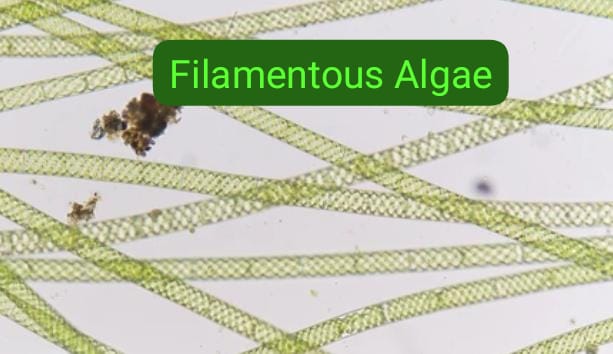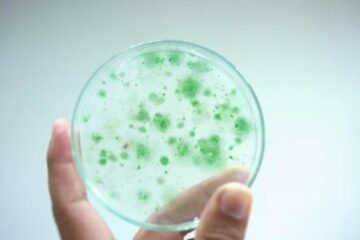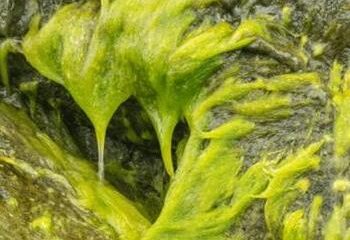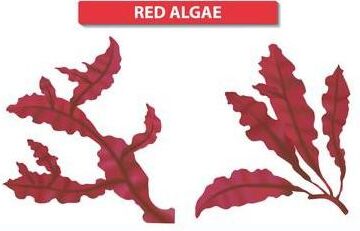Introduction
Filamentous algae, also known as pond scum or string algae, are a diverse group of aquatic plants that play a significant role in various freshwater ecosystems. Unlike the macroscopic, leafy green plants we commonly associate with algae, filamentous algae are composed of long, thread-like strands of cells.
These algae belong to the division Chlorophyta, which includes various green algae species. They can be found in a wide range of aquatic habitats, including ponds, lakes, rivers, and streams. Filamentous algae are known for their rapid growth rates, which can lead to extensive blooms under certain conditions.

Definition
Filamentous algae are aquatic plants with thread-like structures, forming dense green mats in freshwater environments. They play a crucial role in freshwater ecosystems but can become problematic when they overgrow, leading to oxygen depletion and imbalances in the aquatic environment.
Characteristics
- Filamentous structure: As the name suggests, these algae form filamentous chains of cells. The chains can grow and intertwine, creating dense mats or floating masses on the water surface.
- Green color: Most filamentous algae are green due to their chlorophyll content. Chlorophyll is essential for photosynthesis, the process by which they convert sunlight into energy.
- Adaptability: Filamentous algae are highly adaptable to varying environmental conditions. They can thrive in both nutrient-rich and nutrient-poor waters, and their growth can be influenced by factors like temperature, light, and nutrient availability.
- Ecological significance: While filamentous algae can serve as a food source for some aquatic organisms, their excessive growth can have negative impacts on aquatic ecosystems. Large blooms can deplete oxygen levels in the water, leading to fish kills and other detrimental effects on aquatic life.
- Control measures: In some cases, excessive filamentous algae growth can necessitate control measures to maintain a healthy aquatic ecosystem. These measures may include physical removal, chemical treatments, or biological control through the introduction of specific herbivorous organisms.
- Indicator of water quality: The presence of filamentous algae in a water body can indicate changes in water quality, particularly an increase in nutrient levels (such as nitrogen and phosphorus) due to pollution or runoff from agricultural activities.
Understanding filamentous algae and their role in aquatic environments is essential for effective water management and conservation efforts. By monitoring their growth and implementing appropriate measures when necessary, we can help maintain the ecological balance of freshwater ecosystems and ensure the well-being of the organisms that depend on them.
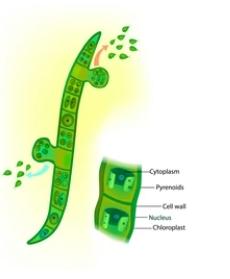
Taxonomy and classification
Filamentous algae belong to the division Chlorophyta, which is part of the kingdom Protista in traditional taxonomy. However, it’s important to note that taxonomy is constantly evolving, and recent advances in molecular biology have led to revisions in the classification of many organisms, including algae.
The division Chlorophyta includes a diverse group of green algae, and filamentous algae are a subset of this division. They are characterized by their green color, which is attributed to the presence of chlorophyll a and b, as well as other pigments like carotenoids.
Within the division Chlorophyta, filamentous algae are further classified into various orders, families, genera, and species based on their morphological, reproductive, and genetic characteristics. Some common genera of filamentous algae include Spirogyra, Cladophora, Oedogonium, Microspora, Zygnema, Pithophora, Ulothrix, and Vaucheria, among others.
It’s important to consult up-to-date taxonomic references and scientific literature for the most accurate and current classification of filamentous algae, as taxonomy is subject to revision based on ongoing research and discoveries. Molecular techniques like DNA sequencing have significantly contributed to refining the classification and understanding the evolutionary relationships among various algae species.
Habitat and distribution
Filamentous algae can be found in a wide range of aquatic habitats, predominantly in freshwater environments. They are commonly present in both standing and flowing waters, including ponds, lakes, rivers, streams, and wetlands. However, filamentous algae can also occur in marine and brackish waters, although they are more prevalent in freshwater ecosystems.
The distribution of filamentous algae is global, and they can be found on almost every continent. Their occurrence is not limited to specific regions but is influenced by various environmental factors such as temperature, light availability, nutrient levels, and water chemistry.
In freshwater habitats, filamentous algae are often abundant in nutrient-rich or eutrophic waters, where excess nutrients like nitrogen and phosphorus support their rapid growth. These nutrients can originate from agricultural runoff, sewage discharges, or other human activities.
In marine environments, certain filamentous algae, like Cladophora and Vaucheria, are more commonly observed in coastal areas, where nutrient levels might be higher due to factors such as upwelling or human influence.
While filamentous algae are an essential component of healthy aquatic ecosystems, excessive growth or blooms can cause ecological issues. Their distribution and abundance can vary seasonally and can be an indicator of water quality and ecosystem health. Understanding the habitat preferences and distribution patterns of filamentous algae is crucial for effective water management and conservation efforts.
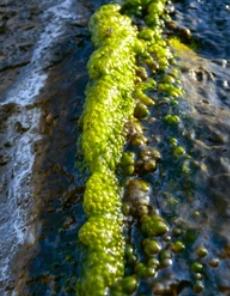
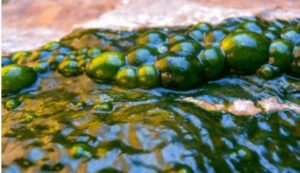
Morphology and structure
The morphology and structure of filamentous algae are distinctive and contribute to their ability to thrive in various aquatic environments. Here are the key characteristics of their morphology and structure:
- Filamentous Growth: As the name suggests, filamentous algae are composed of long, thread-like strands called filaments. These filaments can range in length from a few millimeters to several centimeters, depending on the species.
- Unicellular Structure: Each filament is made up of a chain of single-celled organisms called cells or vegetative cells. These cells are typically cylindrical in shape and are arranged end to end, forming the filament.
- Chloroplasts: The cells of filamentous algae contain chloroplasts, which are responsible for photosynthesis. Chloroplasts contain the pigment chlorophyll, giving the algae its characteristic green color.
- Cytoplasmic Bridges: Adjacent cells within a filament are connected by thin cytoplasmic bridges, allowing for the exchange of nutrients, metabolites, and other substances between the cells.
- Reproduction: Filamentous algae can reproduce through both asexual and sexual means. Asexual reproduction involves cell division within the filament, resulting in the formation of new filaments. Sexual reproduction leads to the production of specialized structures, such as gametes and zygotes, which can undergo fertilization to form new filaments.
- Branched and Unbranched Forms: Filamentous algae can exhibit either unbranched or branched growth patterns. Unbranched filaments consist of a continuous chain of cells, while branched filaments have side branches originating from the main filament.
- Mucilage Sheaths: Some filamentous algae secrete a gelatinous substance called mucilage. This mucilage forms sheaths around the filaments, providing protection and aiding in adhesion to surfaces or to other filaments.
- Attachment Structures: Certain filamentous algae have specialized structures, like holdfasts or rhizoids, that anchor them to surfaces, such as rocks or submerged plants.
The unique morphology and structure of filamentous algae enable them to efficiently absorb nutrients and capture sunlight for photosynthesis. Their filamentous growth allows them to form dense mats or floating masses, which can be beneficial or problematic depending on their abundance and ecological context in aquatic ecosystems.
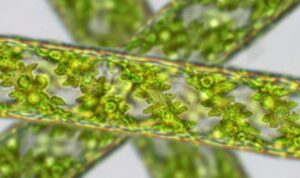
Ecological impacts
The ecological impact of filamentous algae can be both positive and negative, depending on their abundance and the prevailing environmental conditions. Here are some of the key ecological impacts of filamentous algae:
Positive Ecological Impacts:
- Primary Producers: Filamentous algae play a vital role as primary producers in aquatic ecosystems. Through photosynthesis, they convert sunlight into energy and produce oxygen, which is essential for supporting aquatic life.
- Habitat and Food Source: Filamentous algae provide shelter and habitat for various aquatic organisms, including small invertebrates, fish, and other microorganisms. They also serve as a food source for herbivores, contributing to the base of the aquatic food chain.
- Nutrient Cycling: Filamentous algae are involved in nutrient cycling within ecosystems. They take up nutrients from the water, including nitrogen and phosphorus, which can be released back into the environment upon their decomposition, supporting other organisms’ growth.
Negative Ecological Impacts:
- Algal Blooms: Excessive growth of filamentous algae can lead to algal blooms, where they form dense mats or floating masses on the water surface. Algal blooms can reduce light penetration, block oxygen exchange, and deplete dissolved oxygen levels, negatively impacting other aquatic life.
- Oxygen Depletion: During algal blooms, filamentous algae consume large amounts of oxygen during nighttime respiration, leading to oxygen depletion in the water. This can result in fish kills and harm other oxygen-dependent organisms.
- Eutrophication: Filamentous algae are often associated with eutrophic or nutrient-rich waters. Their excessive growth, fueled by high nutrient levels, can contribute to eutrophication, a process where nutrient overload causes imbalances in the ecosystem and alters species composition.
- Biodiversity Impact: Algal blooms can negatively affect biodiversity by outcompeting other aquatic plants for resources and altering the habitat structure, reducing the availability of suitable habitats for various organisms.
- Water Quality Issues: Dense mats of filamentous algae can impede recreational activities, clog water intake pipes, and negatively impact water aesthetics. Moreover, they can release taste and odor compounds, affecting water quality for human consumption.
To maintain a healthy aquatic ecosystem, it is essential to manage filamentous algae growth and prevent excessive blooms. Effective measures may include monitoring nutrient levels, reducing nutrient inputs, promoting natural predators (e.g., grazers), and implementing sustainable water management practices.
Growth and reproduction
The growth and reproduction of filamentous algae are fascinating processes that allow these organisms to proliferate rapidly and adapt to various environmental conditions. Here’s an overview of their growth and reproduction:
Growth of Filamentous Algae:
- Vegetative Growth: Filamentous algae grow primarily through vegetative growth. Each filament is composed of a chain of individual cells. As environmental conditions become favorable, the cells divide, leading to the elongation of the filament.
- Cell Division: Within each filament, cells divide by mitosis, where one cell splits into two identical daughter cells. This process continues along the length of the filament, resulting in elongation.
- Cytoplasmic Bridges: The cells within a filament are connected by cytoplasmic bridges, allowing them to share resources and communicate. This interconnectedness enhances the efficiency of nutrient uptake and photosynthesis.
- Nutrient Uptake: Filamentous algae absorb nutrients, including nitrogen and phosphorus, from the surrounding water. High nutrient levels, often found in nutrient-rich or eutrophic waters, promote rapid growth of filamentous algae.
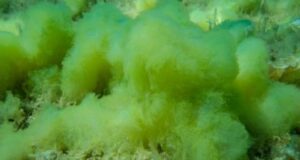
Reproduction of Filamentous Algae:
Asexual Reproduction: Filamentous algae can reproduce asexually through fragmentation or spore formation.
1.Fragmentation: Filaments can break apart into smaller fragments due to environmental disturbances or physical forces. These fragments can grow independently and develop into new filaments.
2.Spore Formation: Some filamentous algae produce specialized reproductive cells called spores. These spores are released into the environment and can germinate to form new filaments when conditions are favorable.
Sexual Reproduction: Filamentous algae also undergo sexual reproduction, which involves the formation of specialized structures for the production and fusion of gametes.
Gametogenesis: During sexual reproduction, certain cells within the filament differentiate into male or female gametangia (gamete-producing structures).
Gamete Release: Male gametangia release motile sperm cells, while female gametangia release non-motile eggs into the water.
Fertilization: Sperm cells swim through the water to fertilize the eggs, leading to the formation of zygotes.
Zygote Development: Zygotes are protected by a thick wall, allowing them to withstand adverse conditions. When conditions become favorable, zygotes germinate, forming new filaments.
Both asexual and sexual reproduction contribute to the rapid population growth and adaptation of filamentous algae to changing environments. Their ability to reproduce through various means enables them to persist and thrive in diverse aquatic habitats, making them an important component of freshwater ecosystems. However, under certain conditions, their rapid growth and reproduction can lead to excessive blooms and ecological imbalances. Effective management strategies are essential to maintain a healthy balance and prevent the negative impacts of filamentous algae in aquatic environments.
Bloom formation and control
Bloom Formation of Filamentous Algae:
Bloom formation of filamentous algae occurs when favorable environmental conditions, combined with high nutrient levels, promote their rapid and excessive growth. Some of the key factors contributing to bloom formation are:
- Nutrient Availability: High concentrations of nutrients, especially nitrogen and phosphorus, can result from agricultural runoff, sewage discharges, or stormwater runoff. These nutrients act as fertilizers for algae, fueling their growth.
- Warm Temperature: Warmer water temperatures, often associated with the summer months, enhance the metabolic rates of filamentous algae, leading to increased growth rates.
- Sunlight: Filamentous algae are photosynthetic organisms that require sunlight to produce energy. Increased sunlight availability promotes their photosynthetic activity and growth.
- Low Predation Pressure: In some cases, reduced grazing pressure from herbivores can contribute to the unchecked growth of filamentous algae.
Control of Filamentous Algae Blooms:
Effective control of filamentous algae blooms is crucial to maintain a healthy balance in aquatic ecosystems and prevent potential ecological problems. Some common control measures include:
- Nutrient Management: Reducing nutrient inputs into water bodies is essential to control algal blooms. This involves managing agricultural runoff, properly treating sewage, and controlling stormwater runoff to minimize nutrient loads.
- Physical Removal: In smaller water bodies or localized areas, physical removal of filamentous algae can be done using rakes or other manual methods. However, this approach is labor-intensive and may require frequent maintenance.
- Biological Control: Introducing natural predators or grazers that feed on filamentous algae can help regulate their populations. For example, certain species of fish, like grass carp, are known to consume filamentous algae.
- Algaecides: In extreme cases, when blooms pose significant environmental or economic threats, algaecides (chemicals that kill or inhibit algae growth) may be used. However, algaecides should be applied judiciously to avoid harming non-target organisms and to prevent the development of resistance in algae populations.
- Nutrient Sequestration: Some engineered solutions involve the use of materials that sequester excess nutrients, preventing them from fueling algal growth. Examples include the use of nutrient-absorbing materials and constructed wetlands.
- Biomanipulation: This approach involves manipulating the composition of the aquatic community to promote the growth of natural grazers and predators of filamentous algae, thereby controlling their population.
- Source Reduction: Implementing best management practices to minimize nutrient runoff and pollution from human activities can be an effective long-term strategy to prevent bloom formation.
The most successful approach to controlling filamentous algae blooms often involves an integrated management strategy that combines multiple methods. Understanding the underlying causes of bloom formation and implementing appropriate control measures are essential for maintaining healthy and balanced aquatic ecosystems.
Types
Filamentous algae encompass a wide variety of species. Some common types of filamentous algae include:
- Spirogyra: Spirogyra is a well-known genus of green algae characterized by its spiral-shaped chloroplasts. It forms long, unbranched filaments and is commonly found in freshwater habitats.
- Cladophora: Cladophora is another common genus of green algae known for its bushy, branched filaments. It often forms dense, green masses and can be found in both freshwater and marine environments.
- Oedogonium: Oedogonium is a filamentous green alga found in various aquatic habitats. It has unbranched filaments and reproduces through asexual and sexual means.
- Microspora: Microspora is a genus of filamentous green algae that forms thin, delicate strands. It is commonly found in freshwater environments and can sometimes be seen floating on the water surface.
- Ulothrix: Ulothrix is a green alga that forms hair-like filaments. It is often found in flowing waters and on wet rocks or submerged surfaces.
- Zygnema: Zygnema is a filamentous green alga that produces zygotes, which are specialized cells resulting from sexual reproduction. These zygotes can withstand adverse conditions and contribute to its survival in fluctuating environments.
- Pithophora: Pithophora is a filamentous green alga known for its dense and fluffy appearance. It is commonly found in nutrient-rich waters and can become problematic during algal blooms.
- Vaucheria: Vaucheria is a filamentous yellow-green alga that often grows in elongated tubes. It is typically found in brackish and marine environments.
These are just a few examples of the many types of filamentous algae that exist. Each type may have its own unique ecological role and adaptations, contributing to the diversity and complexity of freshwater ecosystems.
Examples
Sure! Here are some examples of filamentous algae:
- Spirogyra (Spirogyra spp.): Spirogyra is a well-known genus of green algae characterized by its spiral-shaped chloroplasts. It forms long, unbranched filaments and is commonly found in freshwater habitats.
- Cladophora (Cladophora spp.): Cladophora is another common genus of green algae known for its bushy, branched filaments. It often forms dense, green masses and can be found in both freshwater and marine environments.
- Oedogonium (Oedogonium spp.): Oedogonium is a filamentous green alga found in various aquatic habitats. It has unbranched filaments and reproduces through asexual and sexual means.
- Microspora (Microspora spp.): Microspora is a genus of filamentous green algae that forms thin, delicate strands. It is commonly found in freshwater environments and can sometimes be seen floating on the water surface.
- Zygnema (Zygnema spp.): Zygnema is a filamentous green alga that produces zygotes, which are specialized cells resulting from sexual reproduction. These zygotes can withstand adverse conditions and contribute to its survival in fluctuating environments.
- Pithophora (Pithophora spp.): Pithophora is a filamentous green alga known for its dense and fluffy appearance. It is commonly found in nutrient-rich waters and can become problematic during algal blooms.
- Ulothrix (Ulothrix spp.): Ulothrix is a green alga that forms hair-like filaments. It is often found in flowing waters and on wet rocks or submerged surfaces.
- Vaucheria (Vaucheria spp.): Vaucheria is a filamentous yellow-green alga that often grows in elongated tubes. It is typically found in brackish and marine environments.
These examples represent only a small fraction of the diverse group of filamentous algae that exist in various aquatic habitats around the world. Each species has its own unique characteristics and adaptations, contributing to the overall ecological diversity and complexity of freshwater and marine ecosystems.
Benefits and applications
Filamentous algae offer several benefits and have various applications in different fields. Some of these include:
- Oxygen Production: Filamentous algae, like other photosynthetic organisms, are crucial for oxygen production in aquatic ecosystems. They contribute to maintaining healthy oxygen levels, which are essential for the survival of aquatic organisms.
- Food Source: Some filamentous algae species serve as a food source for aquatic organisms, including small invertebrates, zooplankton, and some fish species. They form an important link in the aquatic food chain.
- Wastewater Treatment: Filamentous algae are used in wastewater treatment processes, where they help in the removal of nutrients and pollutants from the water. Algae-based treatment systems are considered a sustainable and eco-friendly method for wastewater purification.
- Biofuel Production: Certain species of filamentous algae are being studied for their potential in biofuel production. Algae can accumulate lipids or oils, which can be extracted and processed into biodiesel, providing a renewable and environmentally friendly energy source.
- Bioremediation: Filamentous algae are used in bioremediation projects to clean up polluted water bodies. They can absorb heavy metals and other contaminants, helping to improve water quality.
- Carbon Sequestration: Algae, including filamentous algae, can capture and store carbon dioxide from the atmosphere, contributing to efforts to mitigate climate change.
- Fertilizer and Soil Amendment: Decomposing filamentous algae can release nutrients back into the environment, acting as a natural fertilizer for surrounding plants and soil.
- Research and Biotechnology: Filamentous algae are widely studied in research laboratories to understand their biology, genetics, and ecology. They are used as model organisms in various fields, including biotechnology and bioengineering.
- Aquaculture and Fish Farming: Filamentous algae can be cultured and used as a nutritious feed source for fish and other aquatic animals in aquaculture systems.
- Educational and Recreational Purposes: Studying filamentous algae and their ecosystems can provide valuable educational opportunities for students and researchers. Additionally, algae-rich habitats can enhance the aesthetic appeal and recreational value of water bodies, attracting visitors for activities such as birdwatching and nature appreciation.
While filamentous algae have numerous benefits and applications, it is essential to manage their growth and prevent excessive blooms, which can lead to ecological imbalances and water quality issues. A sustainable approach to harnessing their benefits is crucial for maintaining the overall health of aquatic environments.
Conclusion
In conclusion, filamentous algae play a significant role in freshwater and marine ecosystems worldwide. Their thread-like structure, rapid growth, and adaptability allow them to thrive in diverse aquatic habitats. While they offer important ecological benefits, such as oxygen production, serving as food sources, and nutrient cycling, their excessive growth can lead to algal blooms, oxygen depletion, and water quality issues. Effective management and control measures are essential to maintain a healthy balance in aquatic environments and harness the benefits of filamentous algae sustainably. Studying these algae is vital for understanding their ecological impact and exploring their potential applications in fields such as wastewater treatment, biofuel production, and bioremediation. Striking a balance between the positive contributions and the potential challenges posed by filamentous algae is essential for the preservation and conservation of aquatic ecosystems.
Questions and answers
Q: What are filamentous algae?
A: Filamentous algae are aquatic plants composed of long, thread-like chains of cells, commonly found in freshwater habitats.
Q: How do filamentous algae reproduce?
A: Filamentous algae can reproduce both asexually through fragmentation or spore formation and sexually through the production and fusion of gametes.
Q: What are some common types of filamentous algae?
A: Some common types of filamentous algae include Spirogyra, Cladophora, Oedogonium, Microspora, Zygnema, Pithophora, Ulothrix, and Vaucheria.
Q: What ecological role do filamentous algae play in aquatic ecosystems?
A: Filamentous algae serve as primary producers, producing oxygen and providing habitat and food sources for various aquatic organisms.
Q: How do filamentous algae form blooms?
A: Filamentous algae form blooms when favorable environmental conditions, along with high nutrient levels, lead to rapid and excessive growth.
Q: What are the potential consequences of filamentous algae blooms?
A: Filamentous algae blooms can lead to oxygen depletion, fish kills, water quality issues, and ecological imbalances in aquatic ecosystems.
Q: How can filamentous algae be controlled in water bodies?
A: Filamentous algae can be controlled through nutrient management, physical removal, biological control, algaecides, and source reduction of nutrient pollution.
Q: What are the potential applications of filamentous algae in various fields?
A: Filamentous algae have applications in wastewater treatment, biofuel production, bioremediation, carbon sequestration, aquaculture, and as a source of natural fertilizer.
Q: How do filamentous algae contribute to climate change mitigation?
A: Filamentous algae can capture and store carbon dioxide from the atmosphere, aiding in climate change mitigation efforts.
Q: How can filamentous algae be identified in the field?
A: Filamentous algae can be identified based on their thread-like appearance, green color due to chlorophyll, and other distinctive characteristics using basic field guides or microscopes for detailed examination.

